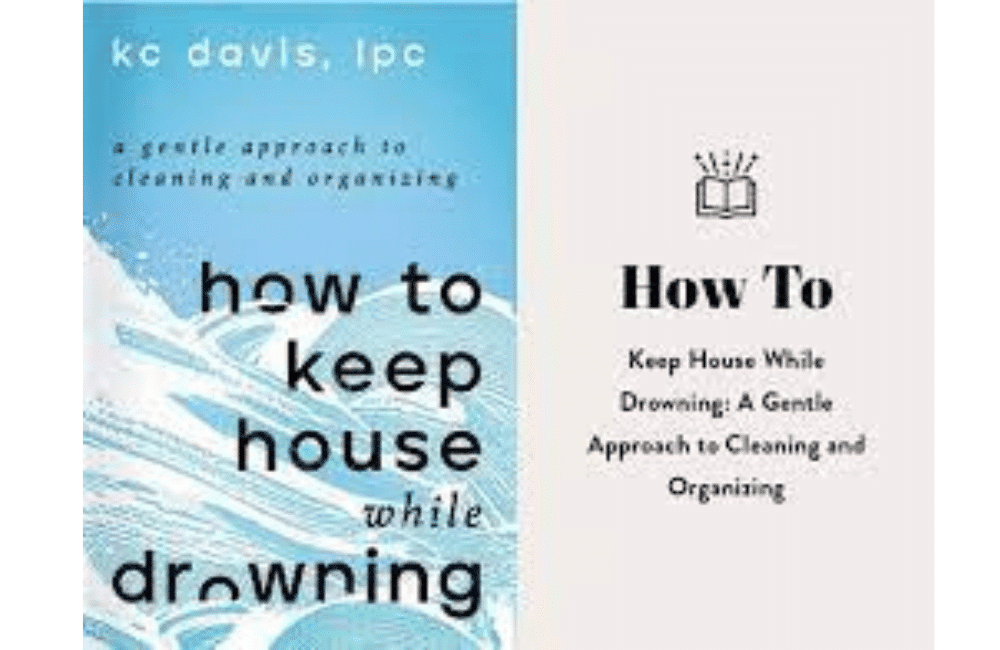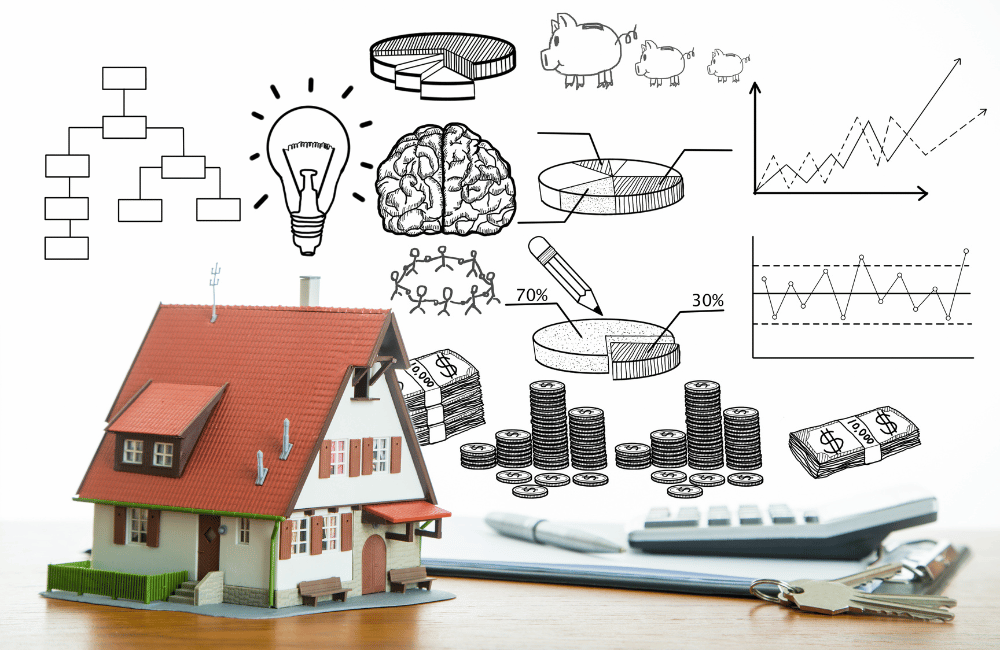Do you feel overwhelmed by the mess in your home? Do you struggle to keep up with the endless chores and tasks that demand your attention? Do you feel ashamed or anxious about the state of your home?

You are not alone if you answered yes to any of these questions. Many people face the same challenges regarding home care, especially when dealing with stress, anxiety, depression, fatigue, ADHD, or lack of support. These factors can make it hard to find the motivation, energy, and time to clean and organize your home.
But there is hope. You don’t have to live in constant chaos and guilt. You can learn to keep house while drowning without feeling overwhelmed or ashamed. You can adopt a gentle approach to cleaning and organizing that works for you and your situation.
In this article, we will introduce you to some principles and strategies to help you achieve a more peaceful and functional home. We will also share some of the resources and tools to support your journey. By the end of this article, you will have a better understanding of how to keep house while drowning and how to start making positive changes in your home and your life.
What Does It Mean to Keep House While Drowning?
The phrase “keep house while drowning” comes from a book by therapist KC Davis called How to Keep House While Drowning: A Gentle Approach to Cleaning and Organizing. In this book, Davis shares her personal story of how she struggled with home care after the birth of her second child. She felt stressed, overwhelmed, and ashamed by the mess in her home. She didn’t fold a single piece of laundry for seven months.

She realized that she was not alone in her struggle. Many of her clients and friends also faced similar challenges with home care. They felt like they were drowning in their own homes, unable to keep up with the demands and expectations of society and themselves.
Davis decided to change her perspective on home care. She realized that she didn’t work for her home; her home worked for her. In other words, messiness was not a moral failing. She learned to let go of the shame-based messaging that interpreted a pile of dirty laundry as “I can never keep up” and a chaotic kitchen as “I’m a bad mother.” Instead, she looked at unwashed clothes and thought, “I am alive,” and at stacks of dishes and thought, “I cooked my family dinner three nights in a row.”
She also learned to adopt a gentle approach to cleaning and organizing that suited her needs and preferences. She stopped following rigid rules and schedules that made her feel inadequate and stressed. She started following simple principles and strategies that helped her create a more functional and comfortable home.
Keeping house while drowning means accepting your situation without judgment, recognizing your strengths and limitations, and finding ways to make your homework for you. It means being kind to yourself and your home and taking small steps toward improvement. It means finding joy and gratitude in your home instead of guilt and resentment.
How Can You Keep House While Drowning?
If you want to keep house while drowning, you must change your mindset and habits. You need to stop comparing yourself to others, blaming yourself for your mess, and feeling like you have to do everything perfectly. You need to start embracing your reality, celebrating your achievements, and doing what works for you.
Here are some of the principles and strategies that can help you keep house while drowning:
Principle 1: Your Home Is Not Your Enemy
The first principle is to realize that your home is not your enemy. Your home is not out to get you or make you feel bad. Your home does not reflect your worth or value as a person. Your home is where you live, work, play, rest, and love.

Your home is not meant to be perfect or pristine. Your home is meant to be lived in and enjoyed. Your home is meant to support you and your goals, not hinder them.
Instead of seeing your home as a source of stress or shame, try to see it as a source of comfort and joy. Instead of focusing on what’s wrong with your home, focus on what’s right with it. Instead of criticizing your home for what it lacks, try to appreciate it for what it offers.
Some ways to practice this principle are:
- Make a list of all the things you love about your home
- Express gratitude for your home every day
- Decorate your home with things that make you happy
- Create cozy spaces in your home where you can relax
- Invite friends or family over to enjoy your home with you
Principle 2: Your Home Is Not Your Boss
The second principle is to realize that your home is not your boss. Your home does not dictate how you should live or what you should do. Your home does not have the power to make you feel guilty or inadequate. Your home does not have the authority to set unrealistic standards or expectations for you.
You are the boss of your home. You decide how you want to live and what you want to do. You can choose what matters to you and what doesn’t. You have the authority to set realistic goals and expectations for yourself.
Instead of letting your home control you, try to take control of your home. Instead of following rules that don’t work for you, try to create rules that do. Instead of doing things that don’t make sense to you, try to do things that do.
Some ways to practice this principle are:
- Make a list of all the things you want from your home
- Prioritize the tasks and projects that are important to you
- Create a flexible and personalized cleaning and organizing routine
- Delegate or outsource the tasks and projects that are not important to you
- Say no to the things that don’t serve you or your home
Principle 3: Your Home Is Not Your Project
The third principle is to realize that your home is not your project. Your home is not something that needs to be fixed or improved. Your home is not something that needs to be finished or completed. Your home is not something that needs to be measured or evaluated.
Your home is something that needs to be enjoyed and appreciated. Your home is something that needs to be used and lived in. Your home is something that needs to be loved and cared for.
Instead of seeing your home as a project, try to see it as a process. Instead of focusing on the end result, focus on the journey. Instead of striving for perfection, try to strive for progress.
Some ways to practice this principle are:
- Make a list of all the things you have done for your home
- Celebrate your achievements and milestones
- Reward yourself for your efforts and hard work
- Learn from your mistakes and challenges
- Embrace the imperfections and quirks of your home
Strategy 1: Start Small
One of the strategies that can help you keep house while drowning is to start small. Starting small means breaking down big tasks and projects into smaller, more manageable ones. Starting small means focusing on one thing at a time instead of trying to do everything at once. Starting small means doing what you can, when you can, with what you have.
Starting small can help you overcome procrastination, overwhelm, and frustration. Starting small can help you build momentum, confidence, and motivation. Starting small can help you achieve more with less stress and effort.
Some ways to practice this strategy are:
- Use a timer or an app to work on a task for a short period of time
- Use a checklist or a planner to track your progress and plan your next steps
- Use a basket or a box to collect items that need to be sorted or put away
- Use a bin or a bag to discard items that need to be thrown away or donated
- Use a tray or a plate to clean one surface or area at a time
Strategy 2: Start Easy
Another strategy that can help you keep house while drowning is to start easy. Starting easy means choosing tasks and projects that are simple and straightforward. Starting easy means doing tasks and projects that are enjoyable and rewarding. Starting easy means avoiding tasks and projects that are complex and challenging.
Starting easy can help you avoid burnout, boredom, and resentment. Starting easy can help you create positive associations and habits with home care. Starting easy can help you have fun and feel good about yourself and your home.
Some ways to practice this strategy are:
- Choose tasks and projects that match your mood, energy, and time
- Choose tasks and projects that align with your values, goals, and preferences
- Choose tasks and projects that make a visible or noticeable difference in your home
- Choose tasks and projects that involve creativity, variety, or novelty
- Choose tasks and projects that involve music, podcasts, audiobooks, or friends
Strategy 3: Start Now
The final strategy to help you keep house while drowning is to start now. Starting now means taking action without delay or hesitation. Starting now means doing something instead of nothing. Starting now means doing the best you can with what you have.
Starting now can help you overcome fear, doubt, and insecurity. Starting now can help you take advantage of opportunities and resources. Starting now can help you make progress and achieve results.
Some ways to practice this strategy are:
- Do one thing every day that improves your home
- Do one thing every time you enter or leave a room
- Do one thing every time you see something out of place
- Do one thing every time you feel motivated or inspired
- Do one thing every time you have a spare moment or a break
These are some of the principles and strategies that can help you keep house while drowning. They are not meant to be rigid or prescriptive but flexible and adaptable. You can use them as guidelines or suggestions and modify them as you see fit. Depending on your situation and needs, you can combine or switch between them.
The main idea is to find a way to clean and organize your home that works for you and your lifestyle. A way that makes you feel happy and proud of your home instead of stressed and ashamed. A way that helps you create a home that supports your well-being instead of sabotaging it.
How Can You Get Help and Support?
Keeping a house while drowning is not easy. It can be challenging, exhausting, and frustrating. It can also be lonely, isolating, and depressing. That’s why getting help and support from others who understand what you’re going through and can offer you guidance, encouragement, and inspiration is important.
There are many ways to get help and support for keeping house while drowning. Some of them are:
- Seek professional help: If you are struggling with mental health issues such as stress, anxiety, depression, ADHD, or trauma, you may benefit from seeking professional help from a therapist, counselor, coach, or psychiatrist. They can help you address the underlying causes of your home care difficulties and provide you with coping skills and strategies to manage them.
- Join a community: If you are looking for people who share your experiences and challenges with home care, you may benefit from joining a community of like-minded individuals. You can find online groups, forums, blogs, podcasts, or social media accounts focusing on keeping house while drowning. You can also find local groups, meetups, workshops, or classes offering home care support and education.
- Hire a service: If you are looking for someone who can help you with the practical aspects of home care, you may benefit from hiring a service specializing in cleaning and organizing. You can find professional cleaners, organizers, declutterers, or handymen who can assist you with your tasks and projects. You can also find apps, websites, or platforms connecting you with your area’s service providers.
- Ask for help: If you are looking for someone who can help you with the emotional aspects of home care, you may benefit from asking for help from your friends or family. You can ask them to listen to your problems, offer advice or feedback, or lend a hand with your chores. You can also ask them to join you in cleaning and organizing efforts or hold you accountable for your goals.
Final Thoughts
Keeping a house while drowning is not impossible. Creating a more peaceful and functional home is possible, even if you feel overwhelmed or ashamed by the mess. It is possible to adopt a gentle approach to cleaning and organizing that works for you and your situation. Finding joy and gratitude in your home is possible instead of guilt and resentment.
All it takes is a change of perspective and a change of habits. All it takes is following simple principles and strategies to help you keep house while drowning. All it takes is getting some help and support from others who can guide you on your journey.
You don’t have to live in constant chaos and guilt. You can learn to keep house while drowning without feeling overwhelmed or ashamed. You can learn to love yourself and your home.
We hope this article has given you useful information and inspiration on keeping house while drowning. We hope it has helped you see hope for your home and life.
If you want to learn more about keeping house while drowning, we recommend reading the book [How to Keep House While Drowning: A Gentle Approach to Cleaning and Organizing] by KC Davis. It is a comprehensive guide that covers everything from the psychology of messiness to the practicalities of decluttering. It contains tips, tricks, stories, and exercises to help you transform your home and yourself.
We also recommend checking out the website [HowToKeepHouseWhileDrowning.com], where you can find more resources and tools on keeping house while drowning. You can also join the newsletter for updates and exclusive home care content.
Thank you for reading this article. We hope it has been helpful to you. We wish you all the best in your home care journey.

